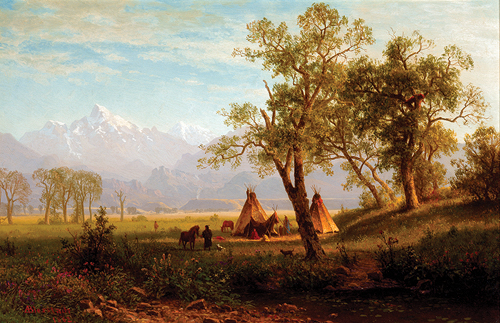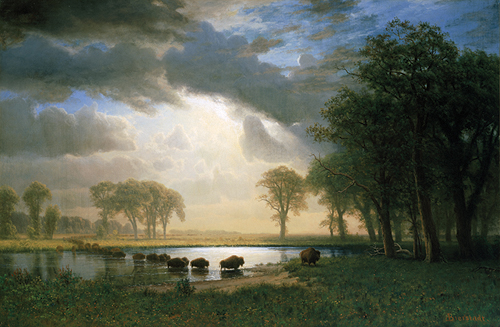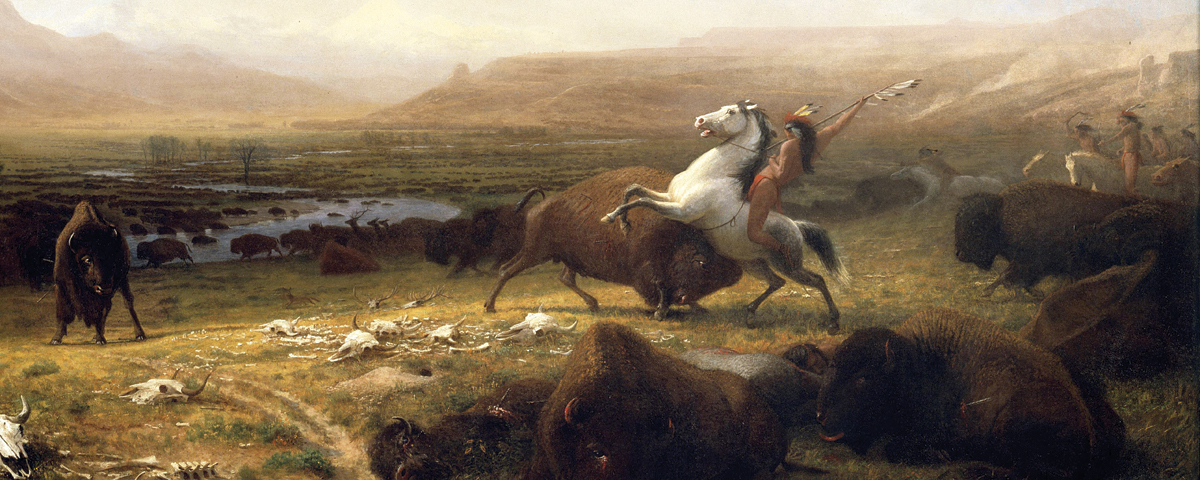Western landscape artist Albert Bierstadt justly earned international fame in the 19th century. Back in the day The Last of the Buffalo, one of two paintings he rendered in 1888–89, sold at the time for $50,000—“the highest price,” art historian Peter H. Hassrick says, “ever paid for an American piece of art in the 19th century.” Yet even before the 72-year-old artist’s death in 1902 his work had fallen out of favor and very nearly out of memory. Not until the 1960s did art historians begin to reevaluate and revere his works, eventually followed by a major exhibition in the early 1990s at the Brooklyn Museum, the Fine Arts Museums of San Francisco and the National Gallery of Art in Washington, D.C. “He’s remembered much more fondly than he has been over past generations,” Hassrick says. The Bierstadt revival continues today.
“Albert Bierstadt: Witness to a Changing West,” which opened last fall at the Buffalo Bill Center of the West’s Whitney Western Art Museum in Cody, Wyo., has moved to the Gilcrease Museum in Tulsa, Okla., where it will continue through February 10. In conjunction with the exhibition the University of Oklahoma Press has published a companion book written by Hassrick, director emeritus and senior scholar at the Buffalo Bill Center, with contributions from other writers. “Bierstadt’s paintings were cinematic before there was cinema,” says contributor Karen McWhorter, Scarlett Curator of Western American Art at the Whitney. To complement the exhibition, the Buffalo Bill Center has commissioned five short films, available for viewing on YouTube and on the center’s website.

Born west of Düsseldorf, Germany, in 1830, Bierstadt immigrated with his parents as an infant to New Bedford, Mass. He showed an early interest in painting and in 1853 went back to Düsseldorf, where he befriended artists Thomas Worthington Whittredge and Sanford Robinson Gifford while studying under Emanuel Leutze (Washington Crossing the Delaware). In 1857 Bierstadt returned to the United States, where became an honorary member of the National Academy of Design and participated in the Hudson River School art movement. His career was cemented two years later when he accompanied Colonel Frederick W. Lander’s expedition to chart an overland trail to Oregon. On his return East he opened a studio in Manhattan’s 10th Street Studio Building, where he began painting his monumental Western landscapes. His impressive 1863 vista The Rocky Mountains, Lander’s Peak sold for a then astounding $25,000.
“Bierstadt was one of the highest-selling artists of the 19th century,” affirms Laura F. Fry, senior curator and curator of art at the Gilcrease. “His work inspired a wide reaction during his lifetime and to the present.”
‘Even the small paintings have such presence that they feel monumental in a way’
Bierstadt’s stunning, massive landscapes, Hassrick explains, were emotionally healing for Americans embroiled in and recovering from the Civil War. “There was a need to say, ‘Hey, this thing we call the United States of America has something special’—we call it today ‘American exceptionalism’—and that was its landscape. I think these paintings, though they are often referred to as exaggerations and fantasies and so forth, were a way of helping salve the conscience of a nation that had been profoundly split apart.”
“Bierstadt is known best as a landscape painter,” McWhorter says. “Even the small paintings have such presence that they feel monumental in a way. I think he stands apart from most of his contemporaries. His landscapes look like places that they are meant to represent. But they also elevate the landscape beyond a worldly dimension. They become this place that’s effused with ethereal light. The scale has just been expanded and extended in every direction. He was really at the top of his game.”
The new exhibition, however, reveals another side of Bierstadt. “It shows how he was—more so than most artists of his day—aware of the impact of the changes occurring in the West in the late 19th century,” explains Fry. “And he actually did something about it.”

Inducted in 1888 as a charter member into the Boone and Crockett Club, a still active wildlife conservation group, Bierstadt joined naturalist/writer George Bird Grinnell and future President Theodore Roosevelt in the club’s efforts to effect legislation against the poaching of Yellowstone National Park bison, then on the brink of extinction. “Bierstadt’s first trip west of the Mississippi,” Fry says, “was in 1859, when the animals were millions. He got to see those bison in those very large numbers, and as he continued traveling west during those next decades, he would have seen those numbers drastically decline.” While Bierstadt lacked both Grinnell’s gift with words and Roosevelt’s clout, he used his talent with brushes and palette to create The Last of the Buffalo, his own last great Western work.
“This painting really brought together the major themes of his career and called for action to prevent this species from extinction,” Fry says. “We hope the exhibition will shed light to audiences on how artists can change the way we think about the world around us.” WW





